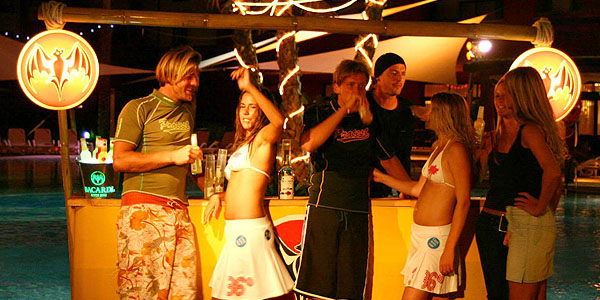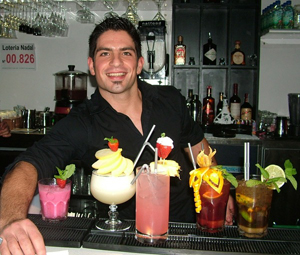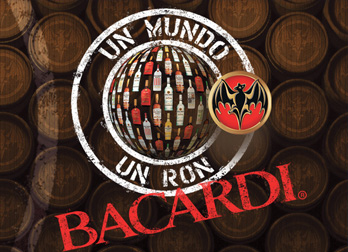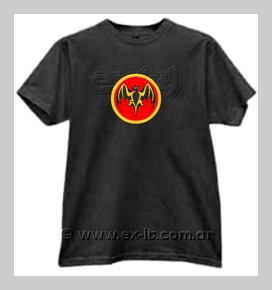Bacardi Company: Difference between revisions
No edit summary |
Alvaromesa (talk | contribs) |
||
| Line 7: | Line 7: | ||
__NOTOC__ | __NOTOC__ | ||
==Main info== | ==Main info== | ||
Facundo Bacardí, a wine merchant, was born in Sitges, Catalonia, Spain in 1814 and emigrated to Cuba in 1830. During this period, rum was cheaply made and not considered a refined drink, one rarely sold in upscale taverns. Don Facundo began attempting to "tame" rum. After experimenting with several techniques he hit upon filtering the rum through charcoal, which removed impurities. In addition to this, Facundo aged the rum in oak barrels, which had the effect of "mellowing" the drink. | |||
Moving from the experimental stage to a more commercial endeavor, he and his brother José set up shop in a Santiago de Cuba distillery they bought in 1862; that distillery housed an alembic made of copper and cast iron, and was in a building in whose rafters lived fruit bats.[4] | |||
The 1880s and 90s were turbulent times for Cuba and the company. Emilio Bacardi, eldest son of Don Facundo, was repeatedly imprisoned in a Spanish prison for (legitimate) suspicions of running a rebel financing and support network during the Cuban War of Independence.[5] | |||
Emilio's brothers, Facundo and José, and his brother-in-law Henri (Don Enrique) Schueg, remained in Cuba with the difficult task of sustaining the company during a period of war. The women in the family were refugees in Kingston, Jamaica. After the war and the U.S. occupation of Cuba, "The Original Cuba Libre" and the Daiquiri were both born with Bacardi rum.[6] In 1899, US- General Leonard Wood appointed Emilio Bacardi Mayor of Santiago de Cuba. | |||
The Bacardi Building in Havana, Cuba. | |||
In 1912, Emilio Bacardi traveled to Egypt where he purchased a mummy for the future Emilio Bacardi Moreau Municipal Museum in Santiago de Cuba, a mummy still on display.[7] In Santiago, his brother Facundo M. Bacardi continued to manage the company along with Schueg, who began the company's international expansion by opening new bottling plants in Barcelona and New York City. The New York plant was soon shut down due to Prohibition, yet during this time Cuba became a hotspot for US tourists. | |||
In the 1920s, Emilio opened a new distillery in Santiago. During this decade, the art deco Bacardi building was built in Havana and the third generation of the Bacardi family was entering the business. Facundo Bacardi invited US-Americans (still subject to Prohibition) to "Come to Cuba and bathe in Bacardi rum."[7] A new product was introduced: Hatuey beer. | |||
The "Cathedral Of Rum" at the Distillery in Puerto Rico near San Juan. | |||
Bacardi's transition into an international brand was due mostly to Schueg's "business genius"; Schueg "branded Cuba as the home of rum, and Bacardi as the king of rums" and moved production overseas, first to Puerto Rico (which enabled rum to be sold tariff-free in the U.S. after Prohibition), and then to Mexico.[8] Those changes were accompanied by a new brand name: Ron Bacardi ("Ron" is the Spanish word for rum). Several trademark disputes went to court during this time regarding uses of the Bacardi name on rum produced outside of Cuba.[citation needed] | |||
During the World War II years the company was led by Schueg's son-in-law José 'Pepin' Bosch. Pepin founded Bacardi Imports in New York City, and was named Cuba's Minister of the Treasury in 1949. | |||
==Members== | ==Members== | ||
Revision as of 22:35, 5 August 2009
|
Main infoFacundo Bacardí, a wine merchant, was born in Sitges, Catalonia, Spain in 1814 and emigrated to Cuba in 1830. During this period, rum was cheaply made and not considered a refined drink, one rarely sold in upscale taverns. Don Facundo began attempting to "tame" rum. After experimenting with several techniques he hit upon filtering the rum through charcoal, which removed impurities. In addition to this, Facundo aged the rum in oak barrels, which had the effect of "mellowing" the drink. Moving from the experimental stage to a more commercial endeavor, he and his brother José set up shop in a Santiago de Cuba distillery they bought in 1862; that distillery housed an alembic made of copper and cast iron, and was in a building in whose rafters lived fruit bats.[4] The 1880s and 90s were turbulent times for Cuba and the company. Emilio Bacardi, eldest son of Don Facundo, was repeatedly imprisoned in a Spanish prison for (legitimate) suspicions of running a rebel financing and support network during the Cuban War of Independence.[5] Emilio's brothers, Facundo and José, and his brother-in-law Henri (Don Enrique) Schueg, remained in Cuba with the difficult task of sustaining the company during a period of war. The women in the family were refugees in Kingston, Jamaica. After the war and the U.S. occupation of Cuba, "The Original Cuba Libre" and the Daiquiri were both born with Bacardi rum.[6] In 1899, US- General Leonard Wood appointed Emilio Bacardi Mayor of Santiago de Cuba. The Bacardi Building in Havana, Cuba. In 1912, Emilio Bacardi traveled to Egypt where he purchased a mummy for the future Emilio Bacardi Moreau Municipal Museum in Santiago de Cuba, a mummy still on display.[7] In Santiago, his brother Facundo M. Bacardi continued to manage the company along with Schueg, who began the company's international expansion by opening new bottling plants in Barcelona and New York City. The New York plant was soon shut down due to Prohibition, yet during this time Cuba became a hotspot for US tourists. In the 1920s, Emilio opened a new distillery in Santiago. During this decade, the art deco Bacardi building was built in Havana and the third generation of the Bacardi family was entering the business. Facundo Bacardi invited US-Americans (still subject to Prohibition) to "Come to Cuba and bathe in Bacardi rum."[7] A new product was introduced: Hatuey beer. The "Cathedral Of Rum" at the Distillery in Puerto Rico near San Juan. Bacardi's transition into an international brand was due mostly to Schueg's "business genius"; Schueg "branded Cuba as the home of rum, and Bacardi as the king of rums" and moved production overseas, first to Puerto Rico (which enabled rum to be sold tariff-free in the U.S. after Prohibition), and then to Mexico.[8] Those changes were accompanied by a new brand name: Ron Bacardi ("Ron" is the Spanish word for rum). Several trademark disputes went to court during this time regarding uses of the Bacardi name on rum produced outside of Cuba.[citation needed] During the World War II years the company was led by Schueg's son-in-law José 'Pepin' Bosch. Pepin founded Bacardi Imports in New York City, and was named Cuba's Minister of the Treasury in 1949. Members
Alvaro Mesa is a Mechanic and Repaired:5 clubs Working on "Mesa productions!"' Baccardi Happy Hour!!
Character name: alvaromesa
Public RelationsMesa productions
Eventos/EventsShows16/07/2009 "Bacardi happy hour" in Club Somerton -Edgecombe. 23/07/2009 "Bacardi forever and ever" in club Club Guilford status
Next event:Club Silvey[99, 48]:"Border Bacardi Ron Part" Free bacardi and new drinks with the music of DJ-Saco!. Tuesday:04-August!
StaffWant to be part of the staff?
Bacardi T-shirts to the staff. |






